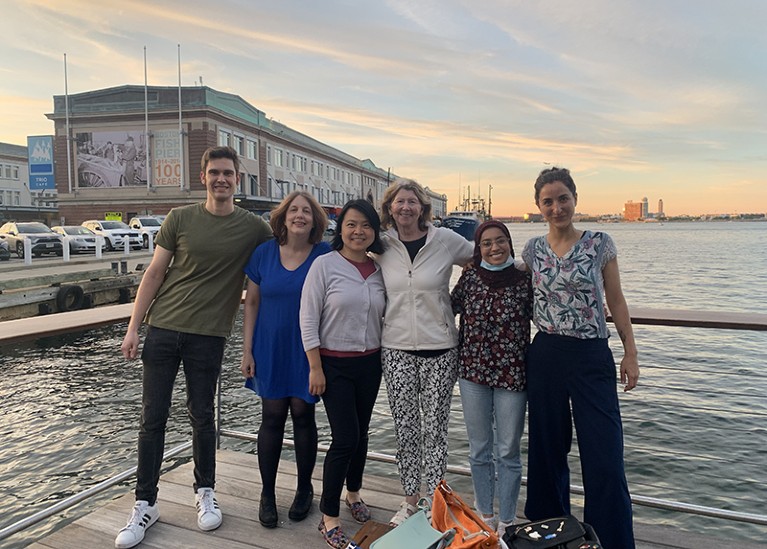
Joyce Bischoff (third from right) with members of her laboratory.
My PhD and postdoctoral fellowship were in basic science — the mechanisms of cells and how proteins get to where they need to go. Towards the end of my postdoc, which was at the Whitehead Institute in Cambridge, Massachusetts, I remember thinking that I really wanted to feel like my research was having an impact on disease.
In 1990, an opportunity arose to join Boston Children’s Hospital as a principal investigator and Harvard Medical School in Boston, Massachusetts, as an assistant professor. It was fantastic because I was exposed to not just research on tumour angiogenesis — the proliferation of a network of blood vessels that supply oxygen and nutrients to a tumour — but also to work on infantile haemangioma. It really opened my eyes. I picked haemangioma — a red mark on the skin that is made up of multiplying blood vessels and one of the most common birthmarks — because this is a tumour that grows dramatically in the first five to six months of a baby’s life and then, in most cases, begins to shrink by the child’s first birthday. Most eventually go away on their own. I thought, wow, you have all the mechanisms of angiogenesis here and maybe if we can learn how this vessel growth and then regression is occurring in haemangiomas, then that knowledge about a regression of blood vessels that supply tumours can be applied to other diseases.
Now, my laboratory is doing basic science on tumour cells, but of course we want this science to be translated to the clinic. A lot of the work we’ve done involves determining how known cancer drugs function, which we hope can help us to come up with new ones.
For example, in 2008, a group in France discovered, kind of by accident, that propranolol, a β-blocker that’s used to treat high blood pressure and various heart conditions, works well on haemangiomas (C. Léauté-Labrèze et al. N. Engl. J. Med. 358, 2649–2651; 2008). But no one knew why. It turns out). But no one knew why. It turns out that the drug is made up of two enantiomers — mirror-image molecular compounds. We found that one of these compounds, (R)-(+)-propranolol, isn’t a β-blocker, so it doesn’t block the effects of adrenaline and reduce blood pressure. Instead, it inhibits haemangioma’s stem cells from forming blood vessels (S. Schrenk and E. Boscolo J. Clin. Invest. 132, e156863; 2022), which are needed to create the tumour.
What does that mean for patients? We’d like to see this research translated and propranolol reformulated into a drug that is just the (R)-(+) enantiomer. This could be used to treat haemangiomas and maybe other vascular abnormalities and cancers. This has to be done in pharmaceutical-grade laboratories, and can be difficult and take a lot of time. Haemangiomas can grow rapidly, but most of the time they are harmless. In rare cases, they can cause organ damage. There aren’t good treatments for haemangioma. Many babies are given propranolol to treat it, but they have to have it for a year or more, and there are potential risks, such as low blood pressure and bronchial spasms — in which the muscles that line the airways in the lung tighten, causing a cough or wheeze.
I spend a lot of time talking one-on-one with the five people in my lab to go over their weekly or biweekly results and discuss where the project is going. A lot of my day is spent writing papers and grants, and preparing to give talks at conferences. On each project, we collaborate with at least one other lab. I think it’s a rich environment.
Scientific research, including mine, is slow and sometimes frustrating. For me, it’s so motivating and compelling to work with all of these clinicians who are super dedicated to their work. I’ve met patients and their families, and that makes the work very meaningful.
This interview has been edited for length and clarity.
This article is part of Nature Spotlight: Research hospitals, an editorially independent supplement. Advertisers have no influence over the content.

